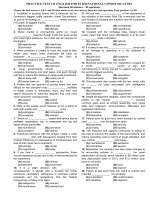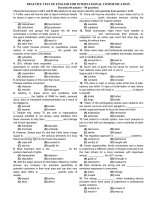English Presentation: International trade is encouraging but it is very risky and requires certain caution. Provide lessons the exporters must learn and security in payment exporters must know
Bạn đang xem bản rút gọn của tài liệu. Xem và tải ngay bản đầy đủ của tài liệu tại đây (71.67 KB, 7 trang )
INTRODUCTION
Nowadays, many companies choose international trade as a way to extend
their business and reach more new markets in the world. This way not only brings
them many benefit but also give them risky. Everything has two sides. So once they
choose international trade, they have to prevent themselves from being risk to gain
the stable development.
CONTENT
I. Definition: International trade
International trade is the exchange of goods or services along international
borders. This type of trade allows for a greater competition and more competitive
pricing in the market. The competition results in more affordable products for
consumer. The exchange of goods also affect the economy of the world as dictated
by supply and demand, making goods and services obtainable which may be
otherwise be available to consumer globally.
Increasing international trade is crucial to the continuance of globalization.
International trade is also brand of economics. It is more costly than domestic trade
II. Advantages and risks of international trade
1. Advantages of international trade
With the help of modern production techniques, highly advanced
transportation systems, transnational corporations, outsourcing of manufacturing
and services, and rapid industrialization, the international trade system is growing
and spreading very fast.
The benefits of international trade have been the major drivers of growth for
the last half of the 20th century. Nations with strong international trade have
become prosperous and have the power to control the world economy. The global
trade can become one of the major contributors to the reduction of poverty.
Several benefits that can be identified with reference to international trade
are as follows:
1
1.1. Greater variety of goods available for consumption
International trade brings in different varieties of a particular product from
different destinations. This gives consumers a wider array of choices which will not
only improve their quality of life but as a whole it will help the country grow.
1.2. Efficient allocation and better utilization of resource
Efficient allocation and better utilization of resources since countries tend to
produce goods in which they have a comparative advantage. When countries
produce through comparative advantage, wasteful duplication of resources is
prevented. It helps save the environment from harmful gases being leaked into the
atmosphere and also provides countries with a better marketing power.
Let’s take a simple example: Country A and country B both produce cotton
sweaters and wine Country A takes three hours to produce ten sweaters and two
hours for six bottles of wine a year while country B produces six sweaters in one
hour and take three hours to produce ten bottles of wine a year. But these countries
realize that they could produce more by focusing on those products with which they
have a comparative advantage. Country A then begins to produce only wine,
country B produces only cotton sweaters. We can see then that for both countries,
the opportunies cost of producing bother products is greater than the cost of
specializing…
1.3. Promotes efficiency in production
International trade promotes efficiency in production as countries will try to
adopt better methods of production to keep costs down in order to remain
competitive. Countries that can produce a product at me lowest possible cost will be
able to gain larger share in the market.
Therefore an incentive to produce efficiently arises. This will help to increase
the standards of the product and consumers will have a good quality product to
consume.
1.4. More employment
More employment could be generated as the market for the countries’ goods
widens through trade. International trade helps generate more employment
through the establishment of newer industries to cater to the demands of various
countries. This will help countries to bring-down their unemployment rates.
When labour specilises skills may improve. Labour therefore becomes more
mobile thus allowing for greater trade in labour.
2
1.5. Consumption at cheaper cost
International trade enables a country to consume things which either cannot
be produced within its borders or production may cost very high. Therefore it
becomes cost cheaper to import from other countries through foreign trade.
1.6. Reducing trade fluctuations
International trade equalizes the prices of goods throughout the world.
As the area of markets is enlarged by trade, the effects of the disturbing factors
are spread over this large area and prices become more stable. If, at any time, the
price of a commodity goes up abnormally, it can be imported from abroad and its
price brought down.
1.7. Utilization of surplus produce
Due to international trade, goods are produced not only for home consumption
but for export to other countries also. It enables different countries to sell their
surplus products to other countries and earn foreign exchange.
1.8. Exchange of technical know-how and establishment of new
industries
Underdeveloped countries can establish and develop new industries with the
machinery, equipment and technical know-how imported from developed countries.
This helps in the development of these countries and the economy of the world at
large.
1.9. Encouraging FDI
International trade not only results in increased efficiency but also allows
countries to participate in a global economy, encouraging the opportunity of
foreign direct investment (FDI), which is the amount of money that individuals
invest into foreign companies and other assets. For the receiving government, FDI is
a means by which foreign currency and expertise can enter the country. These raise
employment levels, and, theoretically, lead to a growth in the gross domestic
product. For the investor, FDI offers company expansion and growth, which means
higher revenues.
1.10. Fostering peace and goodwill
International trade fosters peace, goodwill, and mutual understanding among
nations. The people of different countries come in contact with each other.
Commercial intercourse amongst nations of the world encourages exchange of ideas
and culture. It creates co-operation, understanding, cordial relations amongst
various nations. Economic interdependence of countries often leads to close cultural
relationship and thus avoid war between them.
3
2. Risks of international trade
International trade is regarded is safe way for trade related activities;
however, it is also fraught with a number of risks. We may say that any business
activity involves many risks of several types. Because of these risks, firms are
starting to ask some questions related to the threats that may affect their activity.
The most important questions are: What is the commercial risk in international
business? How do commercial risks arise in export import trade of international
business? What are the factors caused for commercial risk under import export
activity?
There are three types of risks that any organization should be aware when it is
decided to operate in the international market.
2.1. Political risk
Political risk refers to the complications that buyer or seller may expose due to
unfavorable political decisions or political changes that may vary the expected
outcome of an outstanding contract. Examples of political/sovereign risk are
changes in fiscal/monetary policy, war, riots, terrorism, trade embargoes, etc.
These risks arise due to change in political situations in the concerned
importing and exporting countries. Following are the factors, affecting the political
situation:
- Changes in the party in power in the concerned countries, followed by 1 head
of the Government
- Coups, civil wars and rebellions
- Wars between the countries or among- many countries
- Capture of cargo by enemies during war
Political Asks can be avoided, to a certain extent, by judicious selection of the
countries to which goods are exported. Insurance companies may agree to provide
cover for some of these risks, by collecting additional premium. Export Credit.
Guarantee Corporation (ECGC.) also 'covers seine of the risks.
2.2. Transportation risk
Transit risk is the risk of goods being damaged during shipment from the place
of origin to the place of destination. Failure in addressing transit risk may result in
heavy replacement cost or performance risk. Transport costs constitute, generally, a
major part the invoice value and so any change in transport costs affects the
competitive edge of the exporter. Due to long distance between countries, goods are
despatched by shipping or airways. Sea and transport are exposed to many types of
additional risks.
4
2.3. Foreign exchange risk
It can be defined as the variability of a firm’s value due to uncertain changes in
the rate of exchange. A buyer or seller may deal with foreign currencies in their
daily course of business. This implies that they are exposed to fluctuations in foreign
exchange market which may result in paying more (by the buyer) or receiving less
(from the buyer) in terms of the local currency. Three aspects of foreign exchange
risk:
• Transaction risk: The risk of changes in the expected value of a contract
between its signing and its execution as a result of unexpected changes in foreign
exchange rates.
• Translation risk: Gains or losses from the expected value of exchange rate a
contract between its changes that occur as signing and its a result of converting
execution as a result financial statements of unexpected from one currency to
changes in foreign another in order to exchange rates consolidate them.
• Economic risk: Changes in competitive position as a result of permanent
changes in exchange rates.
III. Lessons the exporters must learn
1. Offer customers attractive sale terms and appropriate payment
methods
To succeed in today’s global marketplace and win sales against foreign
competitors, exporters must offer their customers attractive sales terms supported
by appropriate payment methods. Because getting paid in full and on time is the
ultimate goal for each export sale, an appropriate payment method must be chosen
carefully to minimize the payment risk while also accommodating the needs of the
buyer.
2. Open account
An open account transaction is a sale where the goods are shipped and
delivered before payment is due, which is usually in 30 to 90 days. The importer
periodically transfers money to the debt account to pay the exporter. Obviously, this
option is the most advantageous option to the importer in terms of cash flow and
cost, but it is consequently the highest risk option for an exporter. Therefore,
exporters who are reluctant to extend credit may lose a sale to their competitors.
When an open account payment method is used, the exporter in essence grants
the importer a commercial credit, so normally it only applies to parties who have
regular and interrelated relations.
5
However, the exporter can offer competitive open account terms while
substantially mitigating the risk of non-payment by using of one or more of the
appropriate trade finance techniques, such as export credit insurance.
3. Pay suppliers in advance
An advance payment is a type of payment that is made ahead of its normal
schedule, such as paying for a good or service before you actually receive the good
or service. It is the most preferable method of payment, helps your cash flows
positive, and minimizes your risk. However, few buyers will be willing to pay in
advance because they concerns that the goods may not be sent if payment is made
in advance. At this point, exporter can come up with the solution that the importer
just need to pay a part of the cost to secure benefits for both parties.
IV. Some tips about security in payment exporters must know
1. Letter of credit
One of the most secure instruments is a commitment by a bank on behalf of the
buyer that payment will be made to the exporters once paperwork is complete. They
are most commonly used when a buyer in one country purchases goods from a seller
in another country. The seller may ask the buyer to provide a letter of credit to
guarantee payment for the goods.
The main advantage of using a letter of credit is that it can give security to
both the seller and the buyer. Moreover, both bank charge a fee but letters of credit
shift the risk from the business owner to the bank and free up the business’s credit
line.
2. Payment in advance
In the corporate world, companies often have to make advance payments to
suppliers when their orders are large enough to be potentially burdensome to the
producer, should the buyer decide to back out of the deal before delivery. This can
assist producers who do not have enough capital to buy the materials needed to
produce a large order, as they can use part of the advance payment to pay for the
product they will be creating.
3. Terms of delivery
Importing or exporting will be covered by an effective set of delivery terms,
such as using Incoterms. Incoterms (International Commerce Terms) is a set of
internationally recognized rules of trade and widely used worldwide. The Incoterm
provides rules that relate to the price and responsibility of the parties (the seller
and the buyer) in an international trade. It helps to set out fair compensation rules
in the event of a late, damaged or missing delivery.
6
CONCLUSION
If you walk into a supermarket and can buy South American bananas,
Brazilian coffee and a bottle of France wine, you are experiencing the effects of
international trade. Economic theory indicates that international trade raises the
standard of living. A comparison between the performance of open and closed
economies confirms that the benefits of trade in practice are significant.
International trade allows us to expand our markets for both goods and services,
helps economic develop, connects other country, and make success of individual
businesses.
However, shifting politics, new business models and changing societal
expectations are creating new challenges. As a result of international trade, the
market contains greater competition and more competitive prices, therefore
exporters must study and learn lessons carefully in order to gain the success in their
own business.
7









